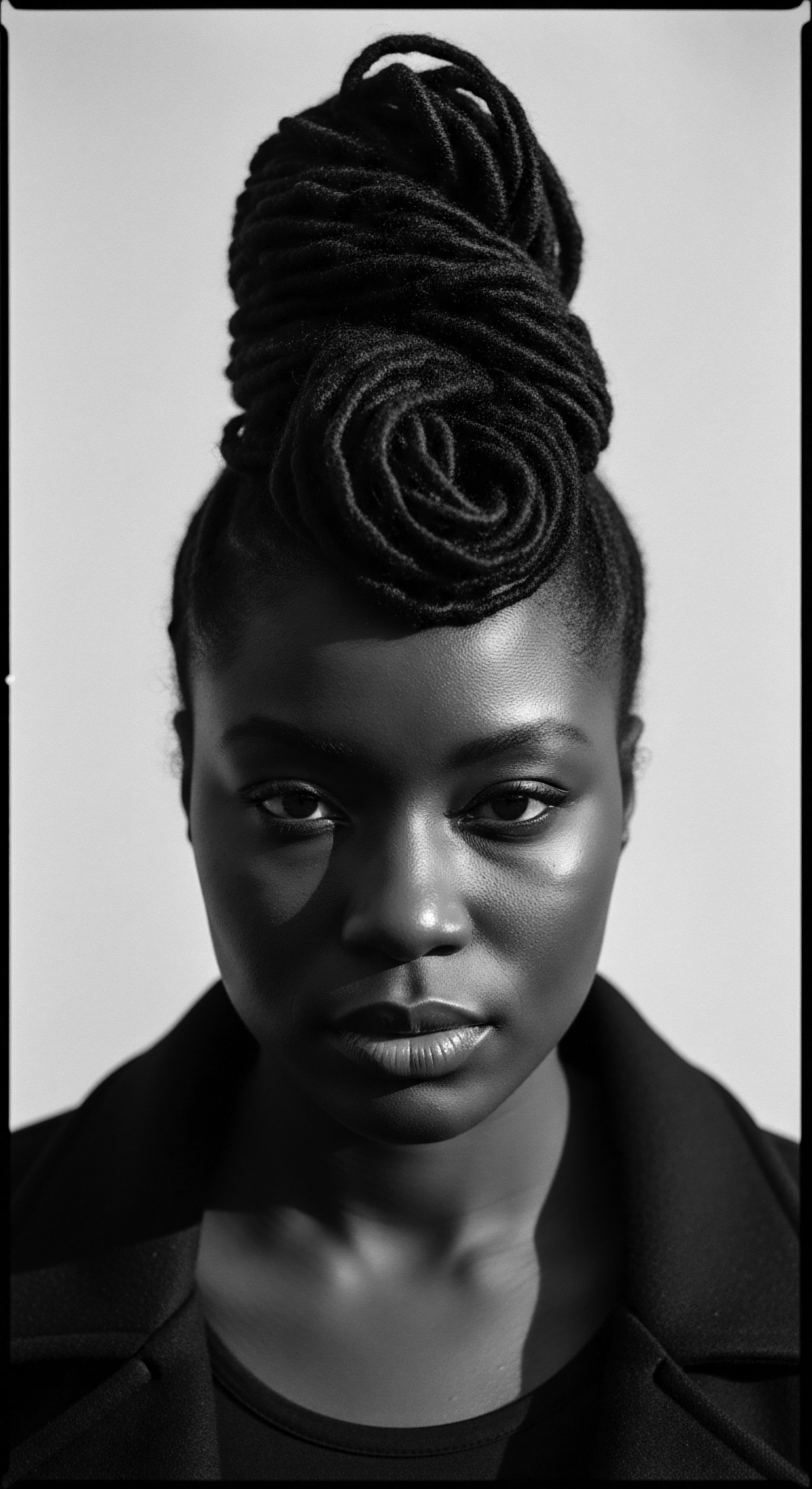
Fundamentals
The Archaeological Hair Study, at its most elemental understanding, represents a dedicated inquiry into the preserved remnants of human hair found within historical contexts. This field seeks to extract stories, whispers of existence, from what might seem like mere biological remains, offering a profound connection to lives lived centuries and millennia past. It stands as a testament to the enduring presence of our ancestors, providing a tangible link to their daily routines, health, diets, and most significantly, their deeply held cultural practices surrounding hair. For those whose lineage traces back to textured hair traditions, this study provides a unique window into a heritage often obscured or diminished by historical narratives, allowing the ancient echoes of Black and mixed-race hair experiences to resonate in our present.
Archaeological Hair Study is a powerful means to rediscover the nuanced historical realities of human life, particularly through the lens of ancient hair traditions and their profound cultural meanings.
From the smallest fragments of ancient braids to the intricately preserved tresses of mummified individuals, each strand offers a microscopic archive of human interaction with the world. This approach, while grounded in scientific rigor, allows for a more soulful understanding of identity and community across civilizations. It illuminates how hair, a seemingly simple biological feature, held complex layers of social, spiritual, and personal significance. The very act of unearthing and examining these remnants becomes a reverent dialogue with those who came before us, especially as we seek to understand the resilience and creativity embedded within ancestral Black and mixed-race hair care.

What Hair Whispers Through Time
Hair possesses an extraordinary capacity to record biographical information. Each segment of a strand can hold chemical signatures of diet, environment, and even certain health conditions endured during life. When archaeologists carefully recover hair from ancient sites, they are not simply finding biological material; they are encountering a preserved record of human existence.
This record speaks volumes about the sustenance available, the toxins encountered, and the overall wellbeing of ancient populations. It helps us reconstruct the environmental landscapes and daily struggles of early communities.
For instance, the hair of the Chinchorro mummies, an ancient fishing culture from the Atacama Desert in present-day Chile, offers powerful insights into their daily lives. Researchers studying Chinchorro mummy hair have found high levels of arsenic, revealing the chronic exposure to this element through their drinking water sources. This specific finding, drawn from the chemical analysis of preserved strands, delineates a vital aspect of their ancient existence, informing us about the challenging environments in which they flourished and adapted. Such analyses go beyond mere identification, providing a window into the lived experiences and environmental interactions of these early peoples.

First Glimpses ❉ Tools and Treasures
The earliest archaeological investigations of hair often began with visual examination and the discovery of associated artifacts. Tools used for hair maintenance, such as combs, pins, and adornments, provide direct evidence of how ancient people interacted with their hair. These artifacts, even when hair itself has not survived, offer invaluable clues about styling practices and the cultural importance placed upon grooming. They are the tangible extensions of ancestral hands, reaching across time to share their knowledge of care.
For instance, archaeological finds from ancient Egypt and Sudan (Kush and Kemet) reveal that the long-toothed Afro Comb has existed for thousands of years, with some examples dated to around 6,000 to 7,000 years ago. These early combs, often crafted from wood, bone, or ivory, were far more than simple grooming instruments; they served as markers of social standing, religious beliefs, and tribal identity. The discovery of such tools provides direct evidence of sophisticated hair care practices in ancient African civilizations.
- Combs ❉ Excavated combs, dating back millennia, offer a direct line to ancient grooming practices, particularly for coily and textured hair.
- Hairpins ❉ Decorative and functional hairpins signify adornment preferences and styling techniques.
- Adornments ❉ Beads, shells, and precious metals found alongside hair remnants speak to the aesthetic and symbolic value placed on hairstyles.

Hair as a Cultural Compass
Hair in ancient societies frequently served as a powerful visual language, communicating a person’s identity, age, marital status, and even social rank without a single spoken word. In many African cultures, specific braiding patterns or hair adornments signaled a person’s affiliation to a particular tribe or community. The way hair was worn could convey a person’s transition through life stages, from childhood to adulthood, or even indicate periods of mourning or celebration. This deep societal meaning elevates hair beyond mere aesthetics, positioning it as a profound cultural artifact in its own right.
| Cultural Context Ancient Egypt |
| Hair's Significance Status, divinity, protection, hygiene. |
| Examples (Heritage Link) Elaborate wigs and braids signified wealth and religious devotion. Mummified hair often preserved styles for the afterlife. |
| Cultural Context Pre-colonial West Africa |
| Hair's Significance Ethnicity, age, marital status, social standing, spiritual beliefs. |
| Examples (Heritage Link) Fulani cornrows and Himba dreadlocks denoted tribal identity and life stages. Braids were visual languages for communication. |
| Cultural Context Ancient Greece & Rome |
| Hair's Significance Gender, age, social status, philosophical affiliation. |
| Examples (Heritage Link) Long hair for men symbolized strength, while elaborate styles for women showed status. Hair also distinguished citizens from foreigners. |
| Cultural Context Understanding these diverse historical contexts allows us to appreciate hair as a universal, yet deeply specific, emblem of human existence and shared ancestral heritage. |

Intermediate
Moving beyond the foundational understanding, the Archaeological Hair Study at an intermediate level truly begins to demonstrate its capacity for revealing the vibrant tapestries of ancestral lives. This involves not only identifying hair but also analyzing its intrinsic properties and the treatments it underwent. It moves from recognizing that hair held meaning to deciphering the nuanced ways in which that meaning was created, maintained, and passed down through generations.
For those attuned to the heritage of textured hair, this deepening examination provides crucial insights into the historical resilience, artistry, and wisdom of Black and mixed-race communities. We begin to see the intimate practices of care and adornment that shaped identities long ago.
Examining hair through an intermediate archaeological lens reveals not just individual stories, but the broader cultural narratives of care, community, and identity expressed through ancestral hair practices.

Deciphering Ancient Strands ❉ Beyond the Surface
The scope of archaeological hair analysis extends far beyond what is visible to the unaided eye. Intermediate studies employ a range of scientific techniques to unearth deeper layers of information from preserved hair. Microscopic analysis can reveal hair structure, density, and even natural color variations.
Chemical analysis can detect residues of ancient hair care products, such as oils, pigments, or styling agents, providing direct evidence of ancestral practices. This scientific engagement allows us to recreate the sensory world of ancient grooming, bringing us closer to the textures and scents that would have defined hair care in centuries past.
For instance, in ancient Egypt, archaeological hair studies have identified the use of various botanical oils, such as castor, almond, and moringa, applied to hair for conditioning and promoting growth. Henna, a plant-based dye, was also used historically by Egyptian embalmers and individuals for hair coloring. These findings connect directly to the practices that formed the basis of traditional hair wellness, demonstrating a sophisticated understanding of natural ingredients for hair health. The meticulous preservation of natural hair in mummified remains provides significant insights into ancient Egyptian hairstyles and the cultural norms surrounding beauty and the afterlife.

The Silent Stories Hair Tells
Hair in ancient societies was rarely a passive element of appearance; it was an active participant in social discourse. Hairstyles served as powerful symbols of age, marital status, and social hierarchy. In pre-colonial African societies, the intricacy of braids, their placement, and the adornments used with them could convey a wealth of information about an individual’s life stage and standing within the community. Communal braiding sessions, for example, were not merely cosmetic events; they acted as vital social rituals, strengthening communal bonds and serving as conduits for passing down cultural knowledge across generations.
The journey of hair through periods of profound upheaval, such as the Transatlantic Slave Trade, underscores its enduring significance as a cultural anchor. During this traumatic era, the forced shearing of hair was a deliberate act of dehumanization, aimed at stripping enslaved Africans of their heritage and identity. Yet, even under such brutal conditions, the knowledge of intricate braiding techniques and protective styles survived, passed down in whispers and through shared rituals.
These styles became forms of silent resistance, expressions of resilience, and powerful assertions of identity against overwhelming adversity. This deep historical connection renders archaeological hair study particularly poignant for understanding the steadfast spirit of Black and mixed-race hair heritage.
- Age Markers ❉ Different hairstyles could indicate a person’s progression from childhood to adolescence and adulthood.
- Marital Status ❉ Specific styles often signaled whether an individual was unmarried, engaged, or married.
- Social Rank ❉ Elaborate coiffures or the use of wigs were often visual cues for wealth and authority.
- Tribal Affiliation ❉ Distinct braid patterns or adornments identified membership in particular ethnic groups.

Custodians of Coils ❉ Preserving the Past
The preservation of hair in the archaeological record depends heavily on specific environmental conditions. Dry, arid environments, like those found in ancient Egypt or the Atacama Desert, are exceptionally conducive to hair preservation, allowing for remarkable detail to endure over millennia. Conversely, moist or acidic soils often lead to the degradation of organic materials, making hair finds rarer in other regions. This variability in preservation challenges archaeologists, but it also elevates the importance of every discovery, particularly when dealing with the delicate remnants of textured hair.
Beyond the natural processes, ancient cultures themselves engaged in practices that aided hair preservation. The elaborate mummification techniques of ancient Egypt, for example, involved treating the deceased’s hair with oils and resins, sometimes even styling it before burial, ensuring its longevity. These intentional acts highlight the sacred regard for hair in ancient worldviews, considering it a vital component of identity even in the afterlife. The care taken to preserve hair reflects a belief in its inherent power and its enduring connection to the individual beyond corporeal life.

Academic
The Archaeological Hair Study, from an academic vantage point, transcends simple identification to become a sophisticated, interdisciplinary domain. This scholarly pursuit involves the rigorous examination of human hair recovered from archaeological sites, employing methodologies drawn from bioarchaeology, forensic anthropology, material culture studies, and molecular biology. The objective is to delineate not just the physical characteristics of ancient hair, but also its comprehensive cultural meaning, social applications, and the biological narratives it embodies across diverse populations.
It is a field that scrutinizes hair as a deeply embedded cultural marker, a biomolecular archive, and a testament to human ingenuity and communal values, particularly when considering the historically rich and often complex experiences of Black and mixed-race communities. The meaning of hair in these contexts is layered, signifying identity, health, and profound spiritual connection.
Academic Archaeological Hair Study systematically unpacks the intricate interplay between human biology, material culture, and profound social meaning embedded within ancient hair, enriching our understanding of ancestral lives.

The Scholarly Lens ❉ Unpacking Archaeological Hair Study
At its core, the academic interpretation of Archaeological Hair Study seeks to establish a comprehensive understanding of human interaction with their own hair and that of others. This involves analyzing hair morphology, such as curl pattern, diameter, and cross-sectional shape, which can provide insights into population affinity and ancestral origins. Beyond morphology, the field investigates residues on hair, which can indicate ancient diets, environmental exposures (e.g. heavy metals), and the application of cosmetic or medicinal substances.
This level of analysis contributes to broader anthropological theories concerning human adaptation, technological development in hair care, and the construction of social identities. The scholarly commitment extends to deciphering how these practices were interwoven with belief systems and community structures, particularly in societies where hair served as a potent form of non-verbal communication.
Scholars approach this study by examining artifacts directly associated with hair, such as combs, adornments, and styling tools, recovered from various archaeological deposits. The presence and design of these objects provide valuable proxy data in instances where hair itself has not survived due to taphonomic processes. Such evidence allows for the reconstruction of ancient grooming rituals and the technology available for hair manipulation, offering a glimpse into the daily lives and aesthetic values of past civilizations. The archaeological record of combs, for instance, is robust, with early examples suggesting their symbolic significance alongside their functional use.

Echoes of Ancestry ❉ A Case from Ancient Nubia and Kemet
To grasp the profound depth of Archaeological Hair Study within textured hair heritage, one must look to the ancient civilizations of Nubia and Kemet (Ancient Egypt), regions that stand as enduring testaments to the sophisticated engagement with hair as a cornerstone of identity and power. A compelling, albeit perhaps less widely recognized, example lies in the enduring legacy of the Afro Comb. The archaeological record provides compelling evidence that the earliest iterations of the Afro comb, a tool intimately associated with the care of coily and textured hair, originated in Africa thousands of years ago. Finds from sites in Sudan and Egypt, areas that were central to the Kush and Kemet civilizations, have unearthed combs resembling modern Afro picks, some dating back as far as 7,000 years.
One such notable artifact is a 5,500-year-old bone comb excavated by archaeologist W.M. Flinders Petrie from grave G78 in the southern cemetery at Abydos, Egypt. This object, housed at the Fitzwilliam Museum, stands as a tangible link to an ancient hair culture that revered and meticulously cared for textured strands. The meticulous crafting of this comb, likely from animal bone, speaks to an advanced understanding of hair morphology and the specific needs of coily hair, predating Western notions of beauty standards by millennia.
These ancient combs were not merely functional; they were often adorned with symbolic carvings, reflecting a civilization’s respect for the natural world and sometimes conveying messages of tribal identity or spiritual significance. The seamless continuity between these ancient artifacts and the modern Afro comb, which became a powerful symbol of Black pride and identity during the Black Power movement, underscores an unbroken lineage of hair knowledge and cultural resilience. The practice of burying these combs with their owners further emphasizes the sacred role hair and its tools played in ancient African societies, demonstrating their enduring belief in the importance of hair even in the afterlife.

The Science of Strands ❉ Unveiling Hidden Histories
Advanced techniques within Archaeological Hair Study allow for microscopic examination of hair, revealing details about hair structure, growth patterns, and even evidence of genetic traits. Scanning electron microscopy (SEM) and light microscopy can determine hair diameter, cuticle patterns, and cross-sectional shape, which often correlate with different hair textures. Molecular analyses, including DNA extraction from hair shafts, offer possibilities for identifying individuals, tracing ancestral lineages, and even discerning certain genetic predispositions within ancient populations. These methods provide a biological foundation for understanding the diversity of hair types present in antiquity.
Beyond morphology, chemical analyses such as gas chromatography-mass spectrometry (GC-MS) can identify lipids, proteins, and residues from ancient hair care products. This enables researchers to ascertain the types of oils, clays, or plant extracts used for cleansing, conditioning, or styling. For instance, the analysis of hair from ancient Egyptian mummies has provided evidence of complex formulations involving animal fats, plant resins, and ochre, used not only for styling but also for ritualistic purposes and preservation. These scientific approaches affirm the deep-seated knowledge of natural ingredients for hair health that existed across various ancient civilizations, including in Africa, India, and the Americas.

Ethical Imperatives and Reclaiming Narratives
The academic pursuit of Archaeological Hair Study necessitates a profound ethical framework, particularly when engaging with the remains of marginalized communities. The history of archaeology has, at times, been intertwined with colonial practices, where human remains, including hair, were collected without consent and for purposes that perpetuated harmful stereotypes. Contemporary archaeological practice, therefore, emphasizes the importance of decolonization, prioritizing respectful engagement, and collaboration with descendant communities.
This involves not only the repatriation of ancestral remains but also the active participation of Indigenous and Black scholars in interpreting and sharing these histories. The focus shifts from merely studying to truly listening to the silenced voices of the past.
For textured hair heritage, this ethical repositioning is vital. It means acknowledging the historical pain associated with the demonization of Black hair textures under colonial beauty standards, where natural hair was often deemed “unprofessional” or “dirty.” By respectfully studying archaeological hair, especially from African and diasporic contexts, scholars contribute to reclaiming these narratives, validating the beauty, sophistication, and cultural richness of ancestral hair practices. It allows for the celebration of hair as a symbol of resistance and a powerful link to an unbroken lineage of cultural pride and self-expression, fostering a deeper, more empathetic understanding of human history through the lens of hair.

Reflection on the Heritage of Archaeological Hair Study
The journey through the Archaeological Hair Study, from its elemental beginnings to its academic complexities, ultimately leads us to a profound reflection on the enduring heritage of textured hair. It reminds us that hair is more than a biological outgrowth; it is a living, breathing archive of human experience, memory, and spiritual connection. The ancient wisdom embedded in the care and adornment of hair, passed down through generations, continues to echo in our present practices, serving as a powerful link to ancestral resilience.
Through archaeological lenses, we see that the ancestral practices surrounding textured hair were never mere acts of grooming. They were expressions of profound cultural identity, communal bonding, and spiritual reverence. The tools, techniques, and adornments uncovered from ancient sites speak to a sophistication and artistry that celebrated the natural forms of hair, long before contemporary ideals of “natural” hair care took hold. This rich history provides a grounding force, connecting current understanding to a continuum of ancestral knowledge.
The silent stories held within preserved strands and ancient combs call upon us to honor this legacy. They invite us to recognize the profound connection between our hair, our history, and our collective identity. The Archaeological Hair Study, at its deepest interpretation, is not just about unearthing the past; it is about tending to the roots of our being, allowing the wisdom of our ancestors to nurture our present, and guiding us toward a future where every strand tells a story of strength, beauty, and belonging.

References
- Ashby, S.P. (ed) (2016). Archaeologies of Hair ❉ the head and its grooming in ancient and contemporary societies. Internet Archaeology 42.
- Bartman, Elizabeth. (2001). Hair and the Artifice of Roman Female Adornment. American Journal of Archaeology 105(1), 1-25.
- Fletcher, Joann. (1998). Ancient Egyptian Hairdressing. Egyptology Today Publications.
- Marshall, Amandine. (2025). The magic and power of hair in ancient Egypt. Ancient Egypt 147.
- Omotos, Adetutu. (2018). The Significance of Hair in Ancient African Civilizations. Journal of Pan African Studies.
- Robins, Gay. (2020). Hair, Gender, and Social Status in Ancient Egypt. JSTOR Daily.
- Solberg, Bergljot. (1993). The Iron Age in Norway ❉ A Survey of the Main Archaeological Evidence. Scandinavian University Press.
- Stephens, Jennifer. (2008). The Science of Hair Care ❉ From Ancient Rituals to Modern Formulations. CRC Press.
- Synnott, Anthony. (1987). Shame and Glory ❉ A Sociology of Hair. The British Journal of Sociology 38(3), 381-413.
- Wilson, A.S. et al. (2007). The Hair of the King ❉ Hair Care, Condition and Disease in Ancient Egyptian Mummies. Journal of Archaeological Science 34(10), 1619-1628.
